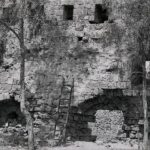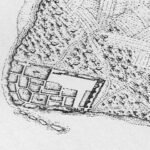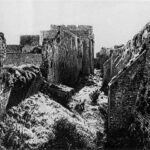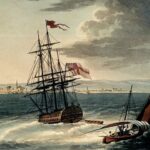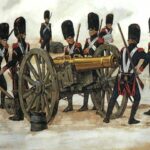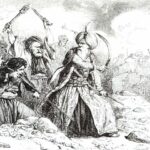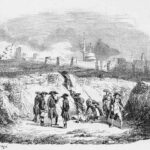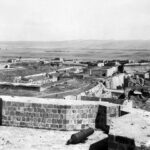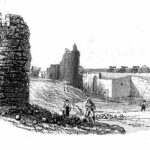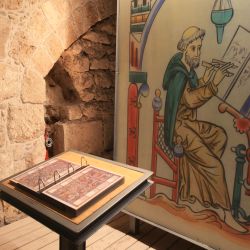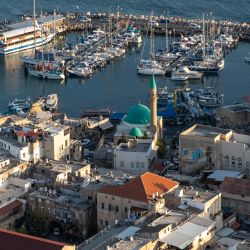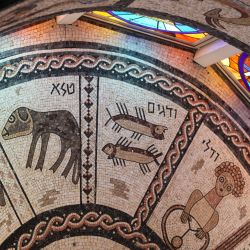Discover how the city stopped Napoleon
At the end of the 18th century, Akko was the main gateway to the Land of Israel from the West. The city will soon face the greatest western commander in modern times – the Frenchman Napoleon Bonaparte.
1 The calm before the storm
In the middle of the 18th century, Daher al-Omar, the ruler of the Galilee, restored the city of Akko, which had been destroyed by the Mamluks in the 13th century, and renovated the ancient land wall in front of you. Ahmad Pasha al-Jazzar, who replaced him in 1775, was appointed commander-in-chief of the Ottoman forces in the Land of Israel and ruled the city and the country with an iron fist. Jazzar strengthens the walls, revets and deepens the moat. At the end of the 18th century, Akko was the main gateway to the Land of Israel from the West. The city will soon face the greatest western commander in modern times – the Frenchman Napoleon Bonaparte.
After proving his skills as a commander and warlord, Bonaparte leaves France in May 1798, at the head of a formidable army – towards Egypt. His goal is to make it a new French colony and through it to continue with his army far to the East. Napoleon’s dream is to conquer India, the diamond in the crown of the British Empire, a move that could turn France into an empire.
2 Clouds of war
Napoleon, the brilliant general, conquers Egypt even though the Middle East is proving to be a much less suitable place for tactics thanks to which he has acquired his military reputation. During the battles he loses most of its navy and remains cut off from Europe. At that time Egypt was part of the Ottoman Empire, which responded by declaring war. Bonaparte decides to advance and attack, and marches with his army North along the coastal plain, on his way to Constantinople (Istanbul today), while conquering settlement after settlement.
After the occupation of Gaza and Ramla, the French army pierces the walls of Jaffa in a few days. Frustrated by the difficult war journey, Napoleon’s soldiers let off steam in the city, killing and looting everything nearby. Unlike his custom, Napoleon chooses to slaughter thousands of prisoners of war who surrendered to him, and makes his way to Akko. To the best of his knowledge, the fortification of Akko is weak and not resistant to a modern siege, but he is unaware of the improvements made by Al-Jazzar, and he does not know how to properly assess Al-Jazzar willingness to fight to the bitter end in his Akko stronghold. In the gardens of the Pasha that spread out in this area of the city, the 79-year-old ruler, who can still
fight, is preparing another surprise for Napoleon.
3 Napoleon approaches
On March 9, 1799, after the rapid conquest of Jaffa, Napoleon sends a disparaging letter to Al-Jazzar, offering to “spare the life of an old man.” He is confident that Akko will also fall into his hands easily, but the Jaffa massacre, whose rumor has already reached Akko, has taught that the commander’s promises should not be trusted. Moreover, now the defenders of the city of Akko knew that they had nothing to lose – even if they did not die in battle, they were not guaranteed to survive as prisoners.
To our left, the remains of the Daher al-Omar wall and at its foot the northern moat that was upgraded by Al-Jazzar in the years before Napoleon’s arrival. The picture shows the remains of this wall in 1925, and at its foot was the moat that was a battlefield.
4 The cannons that "switched sides"
The Ottomans watched with concern the advance of the French army, and great fear prevailed in the city. But more than the defenders were afraid of Napoleon, they feared the governor of the city, and remained on their guard. Ahmad Pasha, nicknamed “Al-Jazzar” (meaning “the Butcher”), had a reputation as a warrior, as a powerful ruler and also as a rigid and cruel man who did not spare even those closest to him.
The British navy also rallied in favor of Akko, and some of its ships captured six of the nine small French ships carrying heavy siege cannons. The cannons were confiscated and placed on the walls of Akko. This move greatly encouraged the city’s defenders. Surprisingly, the loss of the siege cannons did not cause Napoleon to change his plans. He may have believed that the ancient walls of Akko would not withstand even the attack of the light artillery left in his possession. He conquered Al-Arish in Egypt and Jaffa without them. The ancient remains on the slope at your feet are the remains of the northeastern tower of the city during the battle of Napoleon, a tower that was the main focus of battles. Only the foundations of the tower remain today, and it is difficult to make of its plan and boundaries.
5 Quick preparation for battle
On March 19, 1799, Napoleon observed the city from the top of Tel Akko, with 13,000 soldiers and plenty of supplies from nearby Druze settlements. To one of his senior officers he said that “on the shoulders of this small town lies the fate of the East.” Napoleon believed that with the fall of Akko he would be joined by all the Syrians and Druze in Mount Lebanon, who suffered under the iron rule of Al-Jazzar.
The wall you are standing on now did not exist at that time. On the ancient walls of Akko, which northern remains are in front of you, 7000 Al-Jazzar soldiers, hundreds of sailors from the British navy, and many of the city residents stood in front of the French. In the Bay of Akko, three ships of the British Navy stood to cover the city with cannon fire.
Napoleon realized that the corner tower was the most sheltered place from the ships’ fire. The city aqueduct, which at the time reached almost to the base of the tower, was suitable to serve his army as a shelter and base for his attacks. Since he did not bother to hide his intentions, the fire from Akko disrupted the preparations for battle. A preliminary patrol sent to examine the moat at the foot of the walls was attacked and retraced its steps. This mistake cost the French dearly.
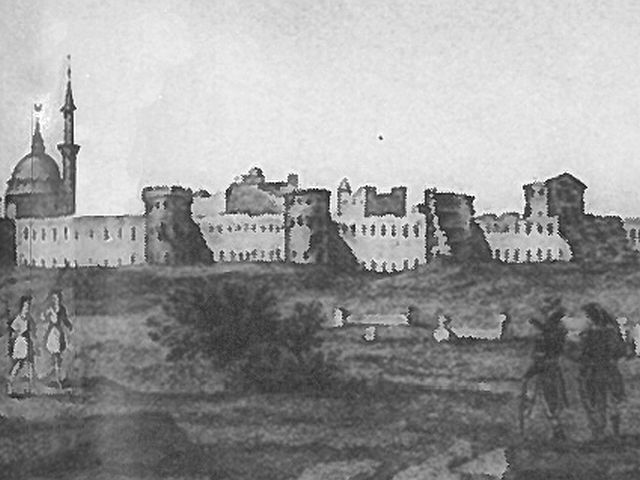
View of the Akko walls as painted by the French in 1799. In the eastern fortification are five towers, the left one is the city gate tower, to its right are three rounded towers followed by the square northeast-corner tower that was repeatedly attacked
6 First attack
On the morning of March 28, the French opened fire with artillery, which was responded with heavy fire from the Akko walls. A frightened turmoil arose in the city and some of the residents fled in their boats. By noon the shells had broken through a section at the top of the corner tower and a pioneer unit equipped with five-meter-long ladders had been sent towards it. To their surprise, they
discovered that the wall of the moat was not sloping as they thought but vertical, and was eight meters deep … Under a murderous fire, they improvised an extension to the ladders and managed to penetrate the ruptured tower. Some of the defenders began to retreat but Al-Jazzar’s arrival at the breach site made them return in fear to their position. He started firing at the French with his pistols, shouting at them. The tower defenders fired down on the attackers through the cracks that opened in the floor and threw hand grenades at them. While Napoleon’s cannons inflicted heavy damage and casualties on the city, reinforcement forces he sent into the breach had difficulty crossing the moat. The number of casualties near the moat increased as a result of the heavy fire that was fired from the sea and from the city. The deplorable state of the attack and the running out of cannon ammunition forced Napoleon to stop the attack. Napoleon realized that he would not easily defeat Akko and the “Old Man” who stood beyond its walls.
7 Siege and explosives
The failure of the first attack forced Napoleon to begin a siege he had not prepared for, and to renew his ammunition supply. Opposite the walls of Akko, his army erected a network of parallel siege trenches with positions for rifles and cannons, and access ditches to the moat. At the same time he began digging tunnels under the city’s corner tower to place an explosive charge under it. Fears of a naval invasion by Ottoman reinforcement forces to Napoleon’s base in occupied Egypt led the experienced commander to hasty decisions time and time again. Five days after the first takeover attempt, before the booby-trapped tunnel reached below the tower itself, Napoleon ordered to explode the bomb and storm a new breach in the wall. As the smoke dissipated it became clear that only minor damage had been done. The Ottomans returned crossfire from the walls and from the Citadel tower (towering over the city in front of you even today). The Ottoman cannons destroyed a section of the aqueduct that served the attackers as a front position, and the French were beaten back with many losses.
8 Cruelty and attrition
The morale of the French army has deteriorated since the first failed attack and as the days went by. They had many dead and wounded, and a plague in which they were infected in Egypt continued to claim victims in the camp.
For weeks the parties continued to bombard each other, ploy tricks and send offensive forces to and from the walls. The French use puppets and scarecrows to make the defenders waste ammunition in vain. They developed a special armor that protects the backs of the soldiers crawling towards the walls. The Akko residents, for their part, threw lanterns along the walls to expose French night attacks and sent dogs to detect the infiltrating enemy soldiers. They threw barrels of gunpowder at the attackers, digging tunnels out of the city to neutralize the French booby-trapped tunnels.
Encouraged by Al-Jazzar, his soldiers beheaded the French wounded and killed heads, and hung them on display on the city walls. It is said that the ruler himself sat on his Citadel roof and awarded a cash prize for every head brought before him. Excavations of a building 200 meters from this point in 1997 found decapitated skeletons, with the remains of a French army uniform. These are French dead soldiers dragged from the battlefield for anonymous burial in the rear lines.

The heads of French soldiers hung by al-Jazzar’s fighters on the Akko walls to show the attackers the fate that awaited them
9 In renewed forces
On May 7, 1799, more than a month after the outbreak of hostilities, vital reinforcements arrived by land for the French – a convoy of heavy artillery from the base in Egypt, and plenty of ammunition. The shouts of joy that came from the French camp were also heard in Akko. The city had already suffered thousands of deaths and it was clear that its ancient walls would not last long. The cannons were immediately deployed along the front, but at noon a fleet of Turkish ships was seen on the horizon approaching the shore. Napoleon realized that if he did not conquer the city before the arrival of reinforcements, he had no chance of winning. Within a short time he carried out an attack with the full force and ammunition of his army.
Again the same corner of the wall was attacked, but this time the new cannons tore a large gap in the walls and the warriors stormed forward. The defenders opposition was as fierce and desperate as that of the French. For many hours the forces attacked each other along and within the moat. Bombs were detonated, hand grenades were thrown and a fierce battle took place inside the ruins of the corner tower. By evening the French had taken over part of it, and their flag was raised for the first time. Exhausted forces stopped the fight during the night, and fear fell on the city defenders.
10 Towards the outcom
On the morning of May 10, the fighting resumed fiercely. The Ottoman reinforcements landing on the shore to your left attacked the French straight from their landing site, and face-to-face battles raged on the walls. Under the bombing of the British ships the French managed to rip another breach in the wall in this area, and they began to break into the city. The commander of the fleet of
ships, noticing the deterioration of the situation in the city, led himself a foot soldiers force to the heart of danger.
But beyond the breach, the surprise that Al-Jazzar had prepared for the French ahead of time was waiting for them – between his gardens and the walls, a new wall was erected that could not be seen from the outside. Hundreds of French soldiers entering through the breach were suddenly forced into a narrow space on their way to the city. Within this “extermination area” the Ottomans prepared combustibles and explosives. They let hundreds of French soldiers enter through the breach and then opened fire on them with cannons from within the city, igniting the combustibles. Those who managed to infiltrate the city encountered checkpoints and warriors armed with swords, and were killed. Soon the orderly column of the French became a bustle of man trying to escape out of the inferno and the flames. Napoleon’s last attack on Akko was halted.
11 The defeat that changed history
The French forces suffered a severe defeat. A large part of their senior officers were killed in the last attack, the morale of the fighters was at its lowest ebb. Many refused to launch further attacks and some shouted insults at Napoleon as he passed through the camp. In the city of Akko, Turkish reinforcements strengthened the defense of the city.
Time worked against Napoleon. News of an Ottoman force preparing to attack its base in Egypt made it clear that its forces were required far south of Akko. On May 20, 1799, he ordered the firing of the rest of the ammunition and shelled the city as a last act on his part. Shortly afterwards, under cover of darkness, his army was assembled and set out on a long and sad journey back to Egypt. The conquest of Asia and India has now become a distant dream.
In the city of Akko remains Ahmad Pasha Al-Jazzar, the cruel old ruler who overcame the great general of the century. Years later Napoleon told the writer of his memoirs: “If Akko had fallen to me, I would have changed the face of the world … The fate of the East was determined in this small town.”
12 The missing wall
The ancient walls of Akko that stood here in 1799, absorbed countless shells in the siege imposed on the city by Napoleon Bonaparte. The shelling caused many sections of the old wall to collapse and later a new wall was erected to your right. In 1840 Akko was under Egyptian control and an Ottoman-British-Austrian coalition laid siege to the city from the sea. The shelling damaged the city’s stockpile of explosives, which was stored in the “Donkey Khan” building, a short distance behind you. The massive explosion, which shook even the ships at sea, killed more than 1,600 fighters and residents, and injured many more. The blast completely wiped out the khan structure and the remains of the ancient eastern wall seen in the painting. The explosion led to a decisive battle and the city returned to the Ottoman Empire.

